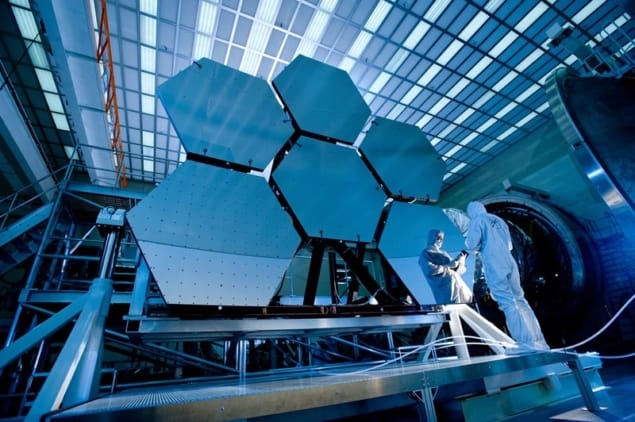
NASA boss Charles Bolden has announced sweeping changes to the management of the $5bn James Webb Space Telescope (JWST) after an independent report called for the space agency to tackle budget overruns and delays to what is one of NASA’s flagship missions. The report by the seven-member JWST review panel, chaired by John Casani from NASA’s Jet Propulsion Laboratory, also says that the telescope will require an additional funding boost of $1.5bn if it is to launch by late 2015.
The JWST, which was due to be launched in 2014, is designed to study the formation of stars and galaxies and examine the physical and chemical properties of solar systems. It will do this by using four onboard instruments – consisting of cameras and spectrometers – that are cooled to only a few degrees above absolute zero by liquid nitrogen.
JWST is mainly a NASA project with collaboration from the European Space Agency and the Canadian Space Agency. But since its conception in the late 1990s the telescope has increasingly eaten into NASA’s resources, consuming around 40% of the agency’s $1bn astrophysics budget in 2010. The review into the JWST was initiated in June by Democrat senator Barbara Mikulski from Maryland over concerns about schedule delays and cost overruns.
Management changes
In its report, the panel notes that the JWST is in “very good technical shape”, saying that cost increases and schedule delays have been caused by “budgeting and program management, not technical performance”. But in a separate letter sent by Casani to Bolden, Casani suggested that the project’s organization needed to be restructured and called for the way the JWST programme is independently assessed to be improved.
The organizational changes to the JWST’s management, announced by Bolden, will involve assigning a new senior manager at NASA headquarters as well as a programme director who will have both technical and cost staff working alongside them. “No-one is more concerned about the situation we find ourselves in than I am,” Bolden states. “I am disappointed we have not maintained the level of cost control we strive to achieve.”
To enable the telescope to launch by September 2015 at the earliest, the panel has called for an extra $1.5bn on JWST’s budget, requiring $250m to be added in 2011 and 2012 and the remainder at a later date. The report notes that the additional funding must go “hand-in-hand” with management changes.
The JWST will have a 6.5 m diameter mirror, consisting of 18 hexagonal folding mirror segments that are each 1.3 m in diameter, giving the telescope a total collecting area of 24 m2. The telescope will operate for around 10 years in an orbit 1.5 million km away from Earth, at a point in space called Lagrange Point 2.



